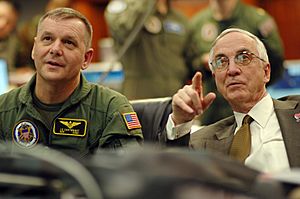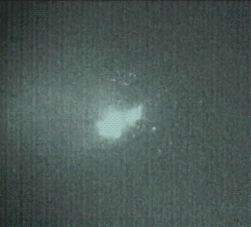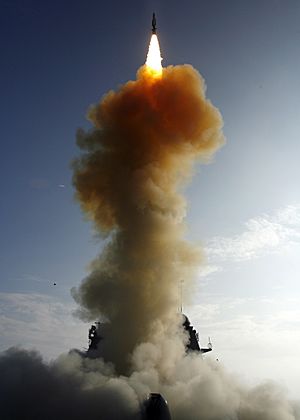Operation Burnt Frost facts for kids
Operation Burnt Frost was a special military mission by the United States. Its goal was to shoot down a broken U.S. satellite called USA-193. This satellite was no longer working and was falling back to Earth.
The main reason for the mission was to protect people. The satellite weighed about 5,000 pounds (2,268 kg). It also carried over 1,000 pounds (453 kg) of a dangerous fuel called hydrazine. If this fuel hit the ground, it could be very harmful.
The mission happened on February 20, 2008. A special missile, a Standard Missile-3 (SM-3), was launched from the USS Lake Erie warship. The missile hit the satellite just a few minutes after launch. This successfully completed the mission. However, some other countries, like China and Russia, were not happy about this operation.
What Was the USA-193 Satellite?
The USA-193 was an American military spy satellite. It was launched into space on December 14, 2006. The satellite was owned by the National Reconnaissance Office (NRO). The exact job of the satellite was kept secret.
Many people believed it was a special radar satellite. This type of satellite takes detailed images of the Earth. It can even see through clouds. This idea was supported because it flew in a similar path to other radar satellites.
The satellite was launched from Vandenberg Air Force Base. It went into orbit successfully. But soon after, ground teams lost control of it. They could not get it to work again.
The satellite itself was not a big danger if it fell. The main worry was its toxic fuel. In 2008, President George W. Bush decided the fuel could cause harm if it spread. So, he ordered the military to destroy the satellite.
How the Mission Happened: A Timeline
The idea to destroy the USA-193 satellite started in December 2007. The actual mission, Operation Burnt Frost, began on January 4, 2008. That's when President Bush gave the order to destroy it.
On January 27, 2008, news came out about the satellite falling. Experts thought it would re-enter Earth's atmosphere in late February or early March. They also thought it was unlikely to hit populated areas.
However, U.S. officials were watching closely. They were looking at ways to "reduce any damage." Four officials, who wished to remain unnamed, said the satellite had toxic rocket fuel. This fuel could be dangerous if its tank did not break apart when it re-entered.
On February 14, 2008, General James Cartwright made a public announcement. He was a high-ranking military officer. He said the U.S. planned to shoot down USA-193. He explained why and how they would do it.
Their main goal was to keep space, air, and land safe. They waited for the Space Shuttle to land first. This was to make sure the shuttle was not in danger. They also wanted to wait until the satellite was close to re-entry. This would create less space debris.
Finally, they did not want the satellite to enter the atmosphere. Its odd shape would make it very hard to hit then. General Cartwright said these rules gave them an eight-day window to act.

The U.S. Navy and its Aegis Ballistic Missile Defense (BMD) system were chosen for the mission. This system could move easily and use the SM-3 missile. The SM-3 could reach the satellite's height. The Aegis BMD system was also chosen because it had a good record. It had successfully shot down 13 out of 15 test missiles.
General Cartwright explained the risk of the satellite hitting Earth in one piece. He said about half of it could survive. This could spread a cloud of toxic hydrazine gas. This cloud could be as big as two football fields. He felt the risk was too high not to act.
Days before the launch, the USS Lake Erie sailed to its launch spot. It was chosen because it was the U.S. Navy's most experienced ship for this type of mission. The USS Decatur was a backup ship.
By February 19, 2008, the satellite was falling faster. Its orbit had dropped by about 10 kilometers in a week.
On February 20, 2008, the Secretary of Defense approved the mission. The missile was launched at 10:26 p.m. EST. It hit the satellite just a few minutes later.
On February 25, 2008, the Department of Defense announced the mission was a success. The dangerous hydrazine tank was destroyed. The risk to people on Earth was greatly reduced.
The mission created 174 pieces of space debris. Most of these pieces fell back to Earth within a few months. A couple of pieces lasted longer because they went into higher orbits. The very last piece of debris fell back to Earth on October 28, 2009.
What Happened After the Mission?
After the operation, China and Russia criticized the U.S. action. This happened shortly after Russia had suggested a new treaty. This treaty would ban weapons in space. China supported this idea.
Russia accused the U.S. of using the hydrazine gas as an excuse. They believed the U.S. was really testing an anti-satellite (ASAT) weapon. They pointed out that other satellites with toxic fuel had crashed before. But they never caused such "extreme measures."
Some people also thought the toxic gas would likely not have survived re-entry anyway. They felt the risk was very small. These ideas led many to believe Operation Burnt Frost was a response to China's ASAT test in 2007. They worried it would start a new "space race" between countries.
U.S. officials denied these claims. They said the mission was not a response to China's test. They also said they were not trying to protect secret satellite technology. To be open, the U.S. told the United Nations that they removed the special changes made to the missiles and ships. They stated the U.S. had "no plans to adapt any technology from this extraordinary effort for use on any current or planned weapon system."
U.S. officials also said they did not need to prove they could shoot down a satellite. They had already done so publicly in the 1980s. General Cartwright also pointed out a key difference. The U.S. intercept happened at a much lower height. China's ASAT weapon destroyed a target much higher up. This created a lot of debris that still threatens other spacecraft. Finally, U.S. officials repeated that the mission's main goal was to protect human lives.




